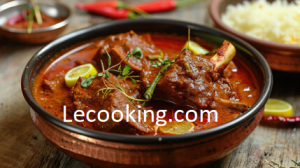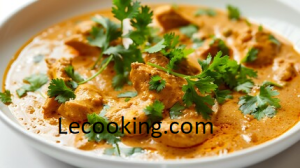Title: A Delectable Guide to Making Authentic Korma: The Essence of Mughlai Cuisine
Korma, a rich and flavorful dish, is a hallmark of Mughlai cuisine, blending aromatic spices with a creamy base of yogurt, nuts, and meat or vegetables. With roots in Persian and Indian culinary traditions, korma has been cherished for centuries, making its way through royal kitchens and into the hearts of food lovers worldwide. This article will guide you through an authentic korma recipe, touching upon its history, the ingredients used, variations, and step-by-step instructions to create a dish that brings the richness of the past into your kitchen.
A Brief History of Korma
The term “korma” originates from the Turkish word “kavurma,” which means to braise or fry. Korma was introduced to the Indian subcontinent by the Mughals, whose royal kitchens were known for their luxurious dishes. Over time, korma evolved into a dish that combined Persian techniques with Indian ingredients, giving birth to an iconic Mughlai recipe. Traditionally prepared for special occasions, korma’s rich gravy and succulent meat were considered a symbol of opulence. It continues to be an integral part of North Indian, Pakistani, and Bangladeshi culinary traditions, served during weddings, festivals, and family gatherings.
Key Ingredients in an Authentic Korma
The soul of korma lies in its ingredients, which vary slightly depending on regional interpretations but always emphasize balance and richness. Below are the essential components of an authentic korma:
- Meat or Vegetables: While korma is typically made with lamb, goat, or chicken, vegetarian versions with paneer, potatoes, or mixed vegetables are equally delicious. Traditionally, mutton (goat) is the preferred meat in Mughlai cuisine.
- Yogurt: The base of korma’s creamy sauce is thick yogurt, which provides tanginess and a smooth texture. It’s essential to use full-fat yogurt to get the right consistency and flavor.
- Nuts and Seeds: Almonds, cashews, and sometimes poppy seeds are blended into the gravy to give it a luxurious creaminess. These nuts also add a slightly sweet undertone to the dish.
- Onions: Onions, fried until golden brown, form the foundation of many Mughlai dishes, including korma. The sweetness of caramelized onions balances the richness of the yogurt and nuts.
- Aromatic Spices: Cardamom, cinnamon, cloves, bay leaves, and nutmeg are common spices used in korma. These spices give the dish its signature fragrance, elevating it from a simple curry to an aromatic feast.
- Ghee or Oil: Korma traditionally uses ghee (clarified butter), which enhances the richness of the dish. However, oil can be used as a lighter alternative.

Variations of Korma
Though the core ingredients remain consistent, there are several regional and cultural variations of korma:
- Shahi Korma: Known for its regal preparation, this version includes saffron and dried fruits like raisins and apricots. The name “Shahi” refers to its royal origins.
- Navratan Korma: A vegetarian version popular in India, Navratan korma includes an assortment of vegetables and nuts. “Navratan” means “nine jewels,” referring to the variety of ingredients used.
- Kashmiri Korma: Originating from the Kashmir region, this version incorporates fennel seeds, yogurt, and dried fruits, often omitting onions and garlic, as the dish is made for religious purposes.
- Hyderabadi Korma: Known for its use of coconut and poppy seeds, this South Indian version has a slightly different flavor profile, blending the Mughlai style with local influences.
Step-by-Step Korma Recipe
Let’s now dive into the process of making a traditional lamb korma. The recipe below serves 4-6 people.
Ingredients
- 1 kg lamb, cut into medium-sized pieces
- 2 large onions, thinly sliced
- 1 cup plain full-fat yogurt (whisked)
- 1/4 cup almonds or cashews (soaked in warm water for 10 minutes)
- 2 tablespoons ghee (or oil)
- 1/2 cup cream (optional for extra richness)
- 1 tablespoon ginger-garlic paste
- 1/2 teaspoon ground turmeric
- 1 teaspoon ground cumin
- 1 teaspoon ground coriander
- 1 teaspoon garam masala
- 4 green cardamom pods
- 1 cinnamon stick
- 4 cloves
- 1 bay leaf
- 2 tablespoons poppy seeds (optional)
- Salt to taste
- Fresh cilantro leaves for garnish

Instructions
- Marinate the Lamb: In a bowl, combine the lamb pieces with yogurt, turmeric, cumin, coriander, and a pinch of salt. Let the lamb marinate for at least 1 hour, or preferably overnight, in the refrigerator. This step helps tenderize the meat and infuse it with flavor.
- Prepare the Nut Paste: Drain the soaked almonds or cashews and blend them with a few tablespoons of water to make a smooth paste. Set this aside; it will add richness to the gravy.
- Fry the Onions: Heat the ghee in a heavy-bottomed pot. Add the sliced onions and fry over medium heat until they turn golden brown and crispy. Be patient with this step, as the caramelization of the onions adds sweetness to the dish. Remove half of the onions and set them aside for garnishing later.
- Add Spices: In the same pot, add the whole spices—cardamom, cinnamon, cloves, and bay leaf—and fry them for a minute until they release their fragrance.
- Cook the Lamb: Add the marinated lamb and the ginger-garlic paste to the pot, cooking over medium heat until the lamb starts to brown. Stir frequently to prevent burning. This browning process helps develop the depth of flavor.
- Simmer the Gravy: Once the lamb is browned, reduce the heat to low and add the nut paste, yogurt, and a little water to the pot. Stir well to combine. Cover the pot and let it simmer for about 1.5 to 2 hours, or until the lamb is tender. Stir occasionally and add more water if the gravy becomes too thick.
- Finish with Cream: If you want a richer korma, stir in the cream during the last 10 minutes of cooking. Adjust the seasoning with salt and garam masala.
- Garnish and Serve: Once the lamb is tender and the gravy has thickened to your desired consistency, turn off the heat. Garnish with the fried onions you set aside earlier and fresh cilantro leaves.
- Serve: Serve your lamb korma with naan, roti, or basmati rice. The creamy, fragrant gravy pairs beautifully with these sides, allowing the korma’s flavors to shine.
Tips for a Perfect Korma
- Slow Cooking: Korma requires patience. Slow-cooking the meat ensures tenderness and allows the spices to infuse deeply into the dish.
- Balancing Flavors: The key to a great korma is balance—between the richness of the nuts, the tanginess of the yogurt, and the warmth of the spices. Taste frequently and adjust the seasoning as needed.
- Variations: Feel free to adapt this recipe by using chicken or paneer instead of lamb, or by adding vegetables like peas and potatoes to create your version.
Conclusion
Korma is more than just a dish; it is a celebration of culinary artistry and history. With its roots in royal Mughal kitche
